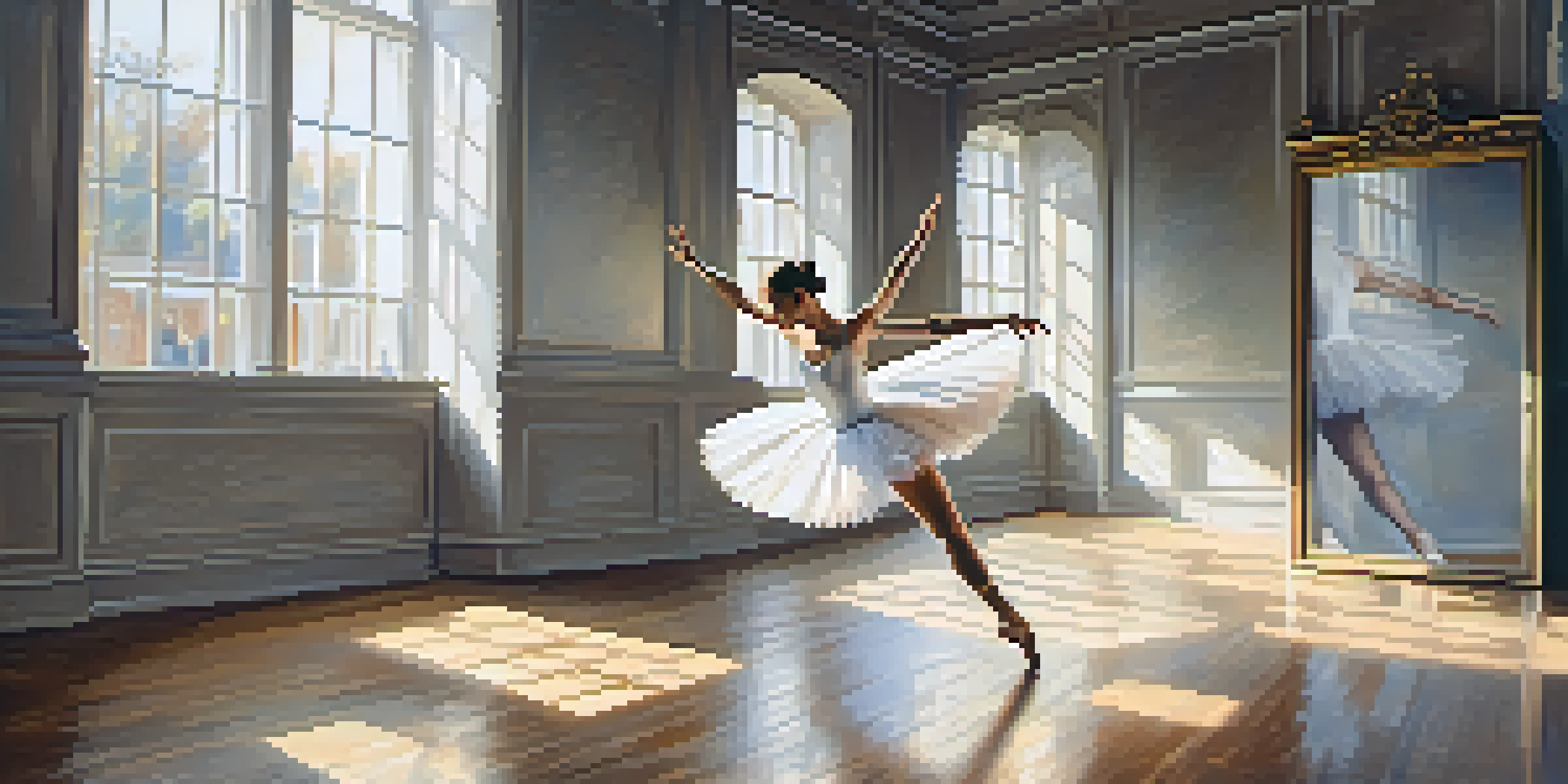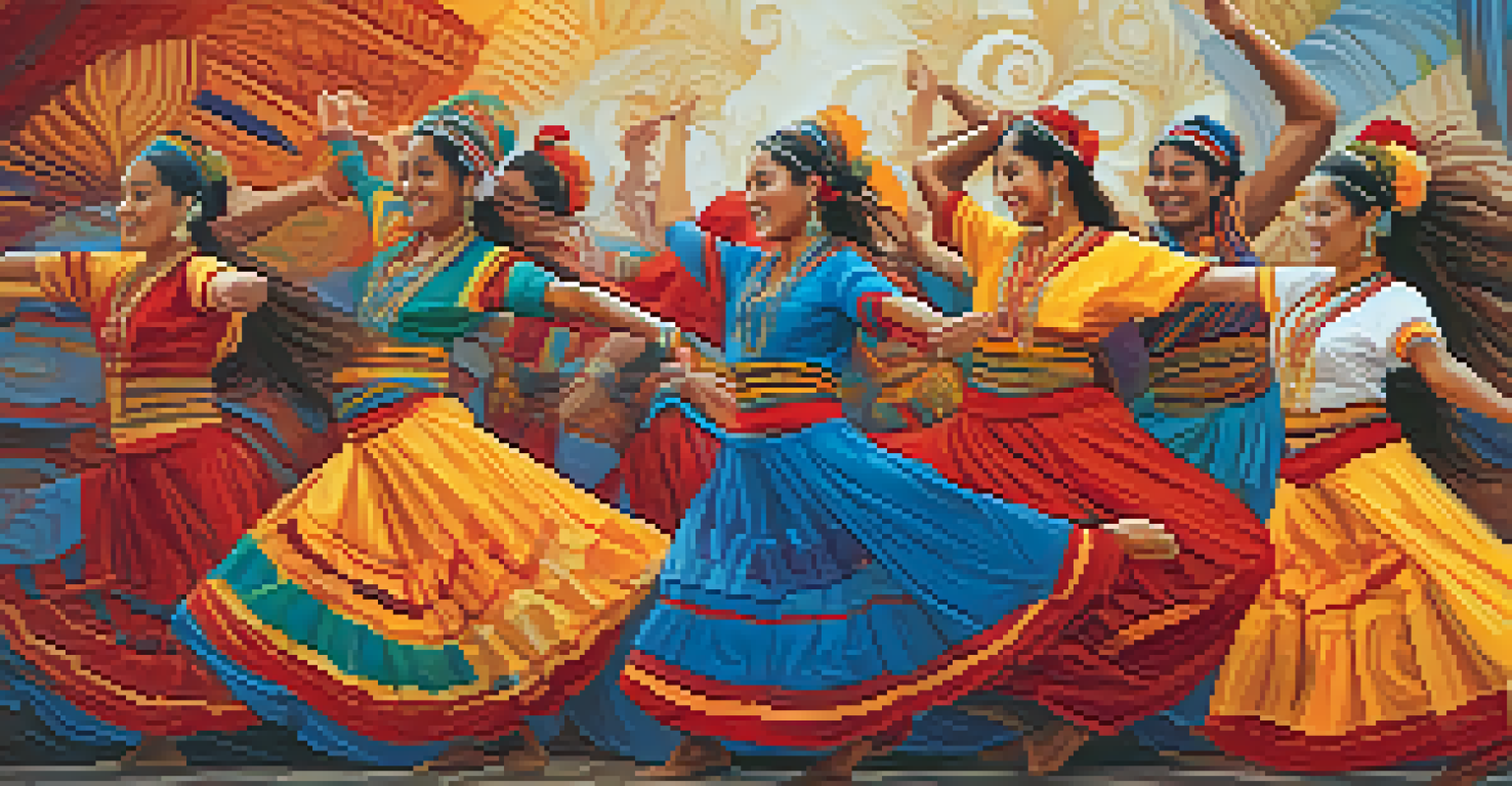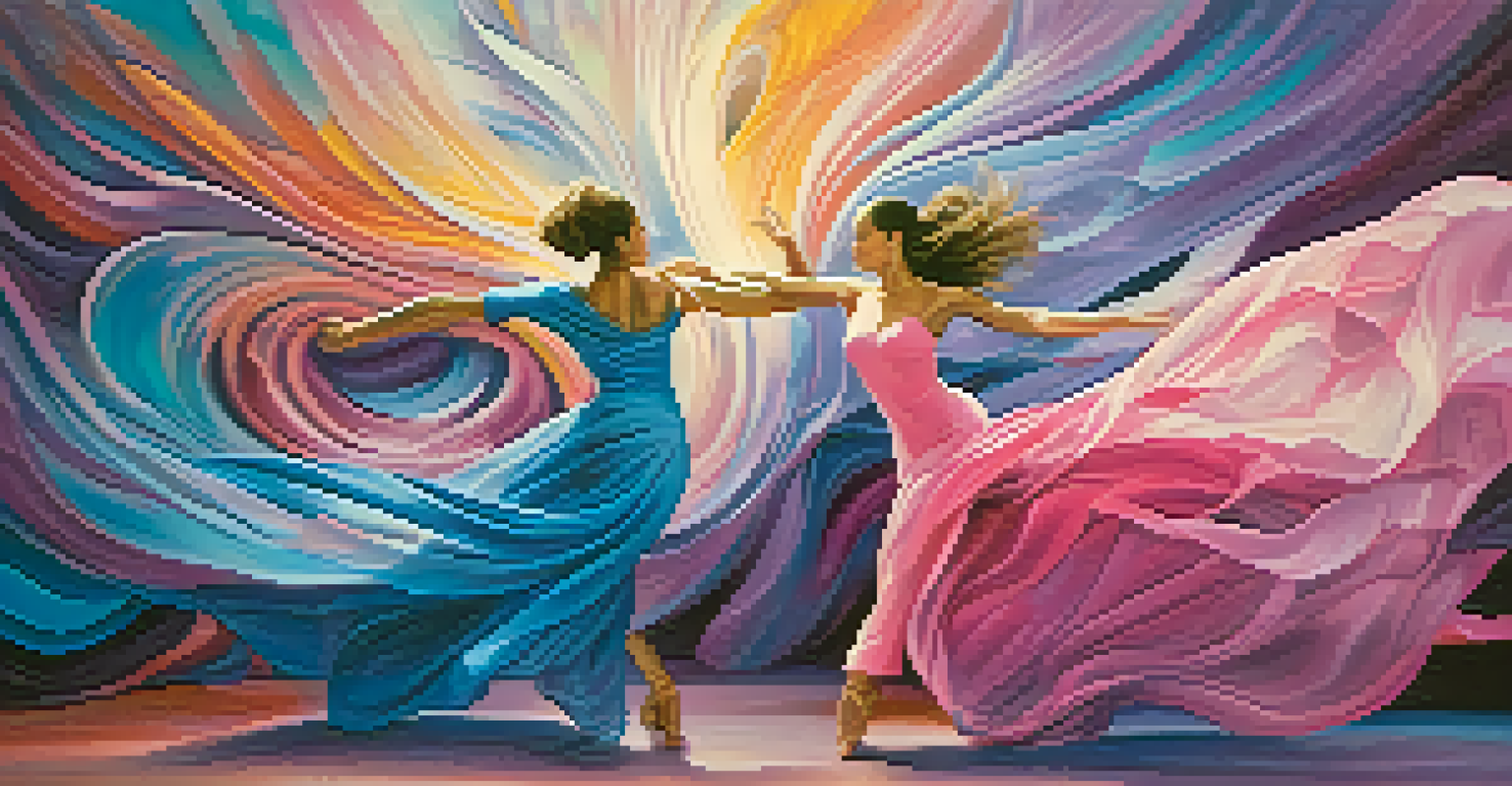Visualizing Movement: Dance as a Subject in Fine Arts

The Essence of Dance in Visual Art
Dance, at its core, is about movement and expression. When artists capture dance in their work, they don't just depict bodies in motion; they convey the emotions and stories behind those movements. This interplay between dance and visual art creates a dynamic experience that resonates with viewers on multiple levels.
Dance is the hidden language of the soul.
Many renowned artists, such as Edgar Degas, famously explored the world of ballet dancers, focusing on their grace and poise. His paintings reveal not only the physicality of dance but also the intense emotions and narratives that accompany it. Through their brushstrokes, these artists invite us to feel the rhythm and energy of the dance.
Ultimately, the essence of dance in visual art lies in its ability to encapsulate fleeting moments, making the ephemeral tangible. This connection between two forms of expression allows us to appreciate the beauty of movement, even when the dancers have left the stage.
Historical Perspectives on Dance in Art
Throughout history, dance has been a significant subject in various art forms, from ancient sculptures to contemporary installations. In ancient Greece, for example, dance was often depicted in pottery and frescoes, symbolizing various deities and cultural celebrations. These early representations laid the groundwork for the ongoing relationship between dance and visual art.

During the Renaissance, artists like Michelangelo and Raphael began to explore the human form with an emphasis on movement and anatomy. This focus on the body allowed for more dynamic representations of dance, capturing the fluidity and grace of figures in motion. It was a pivotal moment that shifted the perception of dance within the artistic community.
Dance Captured in Visual Art
Artists convey the emotions and stories of dance through their work, creating a dynamic experience for viewers.
As we moved into the 19th and 20th centuries, movements like Impressionism and Modernism further evolved this dialogue. Artists sought to convey not just the physical aspects of dance but its emotional depth, leading to innovative representations that pushed the boundaries of traditional art forms.
Dance as a Source of Inspiration for Artists
For many artists, dance serves as a profound source of inspiration that ignites their creativity. The rhythms, patterns, and emotions inherent in dance can lead to unique interpretations in painting, sculpture, and photography. This exchange between disciplines encourages artists to explore new techniques and perspectives.
Art is the most beautiful of all lies.
Take the example of contemporary artist Martha Graham, whose choreography inspired numerous visual artists to create works that reflect her innovative approaches to movement. Her dance not only influenced performance art but also left a lasting mark on the visual arts, demonstrating how interconnected these forms can be.
By incorporating elements of dance into their work, artists can evoke a sense of movement and life, allowing viewers to experience the artwork in a more visceral way. This creative synergy between dance and visual art continues to inspire new generations, proving that movement is a universal language.
The Role of Technology in Visualizing Dance
In recent years, technology has played a pivotal role in how dance is visualized in the fine arts. From digital art to interactive installations, artists are now able to incorporate multimedia elements that expand the boundaries of traditional representations. This innovation allows for a more immersive experience for the audience.
For instance, video art has become a popular medium where choreographers can showcase their work through film, merging dance with visual storytelling. This not only captures the movement but also adds layers of narrative and context, engaging viewers in new and exciting ways.
Cultural Influences Shape Art
The representation of dance in visual art reflects diverse cultural traditions, offering endless inspiration for artists.
Moreover, virtual reality (VR) and augmented reality (AR) have opened up even more possibilities for artists. These technologies allow audiences to step into the artwork, experiencing dance as if they were part of the performance itself, thereby creating a unique interaction that blurs the line between viewer and participant.
Cultural Influences on Dance in Art
Dance is deeply rooted in cultural traditions, and its representation in visual art reflects this diversity. From African tribal dances to classical Indian Bharatanatyam, different cultures have their unique styles and stories that artists strive to capture. This rich tapestry of movement provides endless inspiration for visual creatives.
For example, the vibrant colors and patterns found in traditional Mexican dance have influenced many contemporary artists, who incorporate these elements into their work. By celebrating cultural heritage through dance, artists not only honor their roots but also educate audiences about the significance of these movements.
This cross-cultural exchange enriches the art world, allowing artists to explore and reinterpret dance from various perspectives. As a result, the visual representation of dance becomes a celebration of diversity, inviting viewers to appreciate the beauty of movement across cultures.
Dance as a Narrative Tool in Visual Art
Dance has a unique ability to tell stories, and artists often use it as a narrative tool in their work. By capturing a specific moment in a dance, they can convey a range of emotions and experiences, allowing viewers to engage with the artwork on a deeper level. This storytelling aspect makes the representation of dance particularly compelling.
Take a look at the works of artists like Henri Matisse, who used vibrant colors and fluid lines to depict dancers in motion. His paintings evoke a sense of joy and freedom, inviting the audience to interpret the narrative behind the movements. This emotional connection is what makes dance such a powerful subject in visual art.
Technology Transforms Dance Art
Emerging technologies like VR and AR are revolutionizing how dance is visualized, allowing for immersive audience experiences.
Ultimately, the narrative potential of dance allows artists to explore themes such as love, struggle, and celebration. By intertwining movement with storytelling, they create artworks that resonate with viewers, transforming simple depictions of dance into profound explorations of the human experience.
The Future of Dance in Fine Arts
As we look to the future, the relationship between dance and visual arts is set to evolve even further. With the rise of digital platforms and social media, artists can share their interpretations of dance with a global audience, fostering collaboration and innovation. This accessibility is changing the landscape of how dance is visualized and appreciated.
Emerging artists are increasingly experimenting with new mediums, such as interactive installations and performance art, to create immersive experiences that challenge traditional boundaries. This evolution not only keeps the art form fresh but also invites audiences to actively participate in the dialogue between dance and visual art.

In this ever-changing landscape, one thing remains clear: the connection between dance and visual arts will continue to thrive. As artists push the envelope, we can expect to see even more exciting and creative representations of movement that inspire and captivate audiences worldwide.